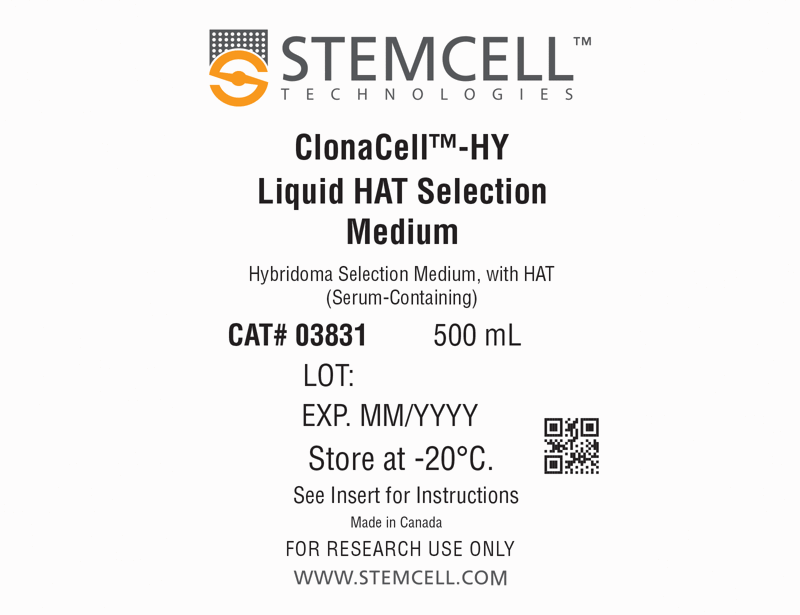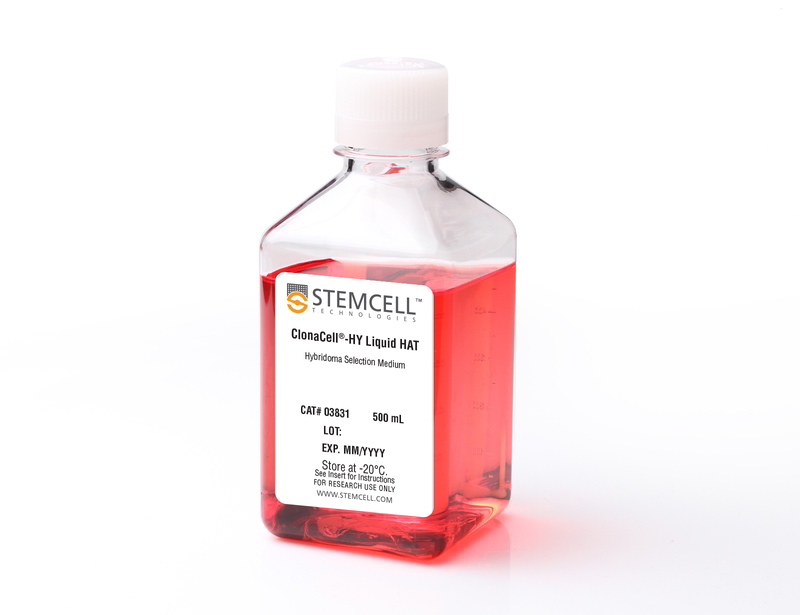ClonaCell™-HY Liquid HAT Selection Medium
Hybridoma selection medium, with HAT (serum-containing)
概要
ClonaCell™-HY Liquid HAT Selection Medium is a serum-containing medium with hypoxanthine, aminopterin, and thymidine (HAT) for the selection of hybridomas following the fusion of lymphocytes and myeloma cells. This medium has been verified for use in mouse and rat hydridoma development and reportedly is compatible for production and cloning of myelomas and/or hybridomas using lymphocytes from a variety of host animals including human, mouse, rat, and hamster.
Advantages
• Simplifies hybridoma selection in liquid suspension cultures
Contains
• DMEM
• Serum
• Hypoxanthine, aminopterin, and thymidine (HAT)
• Gentamicin
• 2-Mercaptoethanol
• Phenol red
• L-Glutamine and other supplements
• Other ingredients
• Serum
• Hypoxanthine, aminopterin, and thymidine (HAT)
• Gentamicin
• 2-Mercaptoethanol
• Phenol red
• L-Glutamine and other supplements
• Other ingredients
Subtype
Specialized Media
Cell Type
Hybridomas
Species
Mouse
Application
Cell Culture, Hybridoma Generation
Brand
ClonaCell
Area of Interest
Antibody Development, Cell Line Development, Drug Discovery and Toxicity Testing, Hybridoma Generation
技术资料
| Document Type | 产品名称 | Catalog # | Lot # | 语言 |
|---|---|---|---|---|
| Product Information Sheet | ClonaCell™-HY Liquid HAT Selection Medium | 03831 | All | English |
| Manual | ClonaCell™-HY Liquid HAT Selection Medium | 03831 | All | English |
| Safety Data Sheet | ClonaCell™-HY Liquid HAT Selection Medium | 03831 | All | English |
数据及文献
Publications (6)
Journal of General Virology 2014
Characterization of an enhanced antigenic change in the pandemic 2009 H1N1 influenza virus haemagglutinin
Abstract
Abstract
Murine hybridomas producing neutralizing mAbs specific to the pandemic influenza virus A/California/07/2009 haemagglutinin (HA) were isolated. These antibodies recognized at least two different but overlapping new epitopes that were conserved in the HA of most Spanish pandemic isolates. However, one of these isolates (A/Extremadura/RR6530/2010) lacked reactivity with the mAbs and carried two unique mutations in the HA head (S88Y and K136N) that were required simultaneously to eliminate reactivity with the murine antibodies. This unusual requirement directly illustrates the phenomenon of enhanced antigenic change proposed previously for the accumulation of simultaneous amino acid substitutions at antigenic sites of the influenza A virus HA during virus evolution (Shih et al., Proc Natl Acad Sci USA, 104 , 6283-6288, 2007). The changes found in the A/Extremadura/RR6530/2010 HA were not found in escape mutants selected in vitro with one of the mAbs, which contained instead nearby single amino acid changes in the HA head. Thus, either single or double point mutations may similarly alter epitopes of the new antigenic site identified in this work in the 2009 H1N1 pandemic virus HA. Moreover, this site is relevant for the human antibody response, as shown by competition of mAbs and human post-infection sera for virus binding. The results are discussed in the context of the HA antigenic structure and challenges posed for identification of sequence changes with possible antigenic impact during virus surveillance.
Molecular and Cellular Endocrinology 2011 JUN
Isolation of mouse pancreatic alpha, beta, duct and acinar populations with cell surface markers
Abstract
Abstract
Tools permitting the isolation of live pancreatic cell subsets for culture and/or molecular analysis are limited. To address this, we developed a collection of monoclonal antibodies with selective surface labeling of endocrine and exocrine pancreatic cell types. Cell type labeling specificity and cell surface reactivity were validated on mouse pancreatic sections and by gene expression analysis of cells isolated using FACS. Five antibodies which marked populations of particular interest were used to isolate and study viable populations of purified pancreatic ducts, acinar cells, and subsets of acinar cells from whole pancreatic tissue or of alpha or beta cells from isolated mouse islets. Gene expression analysis showed the presence of known endocrine markers in alpha and beta cell populations and revealed that TTR and DPPIV are primarily expressed in alpha cells whereas DGKB and GPM6A have a beta cell specific expression profile.
The Journal of Experimental Medicine 2008 MAY
Essential role of TNF receptor superfamily 25 (TNFRSF25) in the development of allergic lung inflammation
Abstract
Abstract
We identify the tumor necrosis factor receptor superfamily 25 (TNFRSF25)/TNFSF15 pair as critical trigger for allergic lung inflammation, which is a cardinal feature of asthma. TNFRSF25 (TNFR25) signals are required to exert T helper cell 2 (Th2) effector function in Th2-polarized CD4 cells and co-stimulate interleukin (IL)-13 production by glycosphingolipid-activated NKT cells. In vivo, antibody blockade of TNFSF15 (TL1A), which is the ligand for TNFR25, inhibits lung inflammation and production of Th2 cytokines such as IL-13, even when administered days after airway antigen exposure. Similarly, blockade of TNFR25 by a dominant-negative (DN) transgene, DN TNFR25, confers resistance to lung inflammation in mice. Allergic lung inflammation-resistant, NKT-deficient mice become susceptible upon adoptive transfer of wild-type NKT cells, but not after transfer of DN TNFR25 transgenic NKT cells. The TNFR25/TL1A pair appears to provide an early signal for Th2 cytokine production in the lung, and therefore may be a drug target in attempts to attenuate lung inflammation in asthmatics.
The Journal of Immunology 2006 SEP
Antibody targeting to acClass I MHC-peptide epitope promotes tumor cell death
Abstract
Abstract
Therapeutic mAbs that target tumor-associated Ags on the surface of malignant cells have proven to be an effective and specific option for the treatment of certain cancers. However, many of these protein markers of carcinogenesis are not expressed on the cells' surface. Instead these tumor-associated Ags are processed into peptides that are presented at the cell surface, in the context of MHC class I molecules, where they become targets for T cells. To tap this vast source of tumor Ags, we generated a murine IgG2a mAb, 3.2G1, endowed with TCR-like binding specificity for peptide-HLA-A*0201 (HLA-A2) complex and designated this class of Ab as TCR mimics (TCRm). The 3.2G1 TCRm recognizes the GVL peptide (GVLPALPQV) from human chorionic gonadotropin beta presented by the peptide-HLA-A*0201 complex. When used in immunofluorescent staining reactions using GVL peptide-loaded T2 cells, the 3.2G1 TCRm specifically stained the cells in a peptide and Ab concentration-dependent manner. Staining intensity correlated with the extent of cell lysis by complement-dependent cytotoxicity (CDC), and a peptide concentration-dependent threshold level existed for the CDC reaction. Staining of human tumor lines demonstrated that 3.2G1 TCRm was able to recognize endogenously processed peptide and that the breast cancer cell line MDA-MB-231 highly expressed the target epitope. The 3.2G1 TCRm-mediated CDC and Ab-dependent cellular cytotoxicity of a human breast carcinoma line in vitro and inhibited in vivo tumor implantation and growth in nude mice. These results provide validation for the development of novel TCRm therapeutic reagents that specifically target and kill tumors via recognition and binding to MHC-peptide epitopes.
Journal of Immunology (Baltimore, Md. : 1950) 2006 OCT
Levels of specific peptide-HLA class I complex predicts tumor cell susceptibility to CTL killing.
Abstract
Abstract
Recognition of tumor-associated Ags (TAAs) on tumor cells by CTLs and the subsequent tumor cell death are assumed to be dependent on TAA protein expression and to correlate directly with the level of peptide displayed in the binding site of the HLA class I molecule. In this study we evaluated whether the levels of Her-2/neu protein expression on human tumor cell lines directly correlate with HLA-A*0201/Her2/neu peptide presentation and CTL recognition. We developed a TCR mimic (TCRm) mAb designated 1B8 that specifically recognizes the HLA-A2.1/Her2/neu peptide (369-377) (Her2(369)-A2) complex. TCRm mAb staining intensity varied for the five human tumor cell lines analyzed, suggesting quantitative differences in levels of the Her2(369)-A2 complex on these cells. Analysis of tumor cell lines pretreated with IFN-gamma and TNF-alpha for Her2/neu protein and HLA-A2 molecule expression did not reveal a direct correlation between the levels of Her2/neu Ag, HLA-A2 molecule, and Her2(369)-A2 complex expression. However, compared with untreated cells, cytokine-treated cell lines showed an increase in Her2(369)-A2 epitope density that directly correlated with enhanced tumor cell death (p = 0.05). Although a trend was observed between tumor cell lysis and the level of the Her2(369)-A2 complex for untreated cells, the association was not significant. These findings suggest that tumor cell susceptibility to CTL-mediated lysis may be predicted based on the level of specific peptide-MHC class I expression rather than on the total level of TAA expression. Further, these studies demonstrate the potential of the TCRm mAb for validation of endogenous HLA-peptide epitopes on tumor cells.
Glycobiology 2006 APR
Immunoglobulin G specifically binding plant N-glycans with high affinity could be generated in rabbits but not in mice.
Abstract
Abstract
Xylosylated and core alpha1,3-fucosylated N-glycans from plants are immunogenic, and they play a still obscure role in allergy and in the field of plant-made protein pharmaceuticals. We immunized mice to generate monoclonal antibodies (mAbs) binding plant N-glycans specifically via the epitope containing either the xylose or the core alpha1,3-fucose residue. Splenocytes expressing N-glycan-specific antibodies derived from C57BL/6 mice previously immunized with plant glycoproteins were preselected by cell sorting to generate hybridoma lines producing specific antibodies. However, we obtained only mAbs unable to distinguish fucosylated from xylosylated N-glycans and reactive even with the pentasaccharide core Man3GlcNAc2. In contrast, immunization of rabbits yielded polyclonal sera selectively reactive with either fucosylated or xylosylated N-glycans. Purification of these sera using glyco-modified neoglycoproteins coupled to a chromatography matrix provided polyclonal sera suitable for affinity determination. Surface plasmon resonance measurements using sensor chips with immobilized glyco-modified transferrins revealed dissociation constants of around 10(-9) M. This unexpectedly high affinity of IgG antibodies toward carbohydrate epitopes has repercussions on our conception of the binding strength and significance of antiglycan IgE antibodies in allergy.


